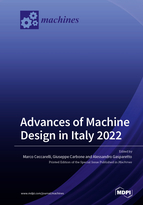Advances of Machine Design in Italy 2022
A special issue of Machines (ISSN 2075-1702). This special issue belongs to the section "Machine Design and Theory".
Deadline for manuscript submissions: closed (31 July 2022) | Viewed by 34312
Special Issue Editors
Interests: mechanism design mechanics of robots; robot design
Special Issues, Collections and Topics in MDPI journals
Interests: robotics; robot design; mechatronics; walking hexapod; design procedure; mechanics of machinery; leg–wheel
Special Issues, Collections and Topics in MDPI journals
Special Issue Information
This Special Issue is aimed to present and circulate recent developments and achievements in the field of Machine Design coming from the Italian community with international collaborations and ranging from theoretical contributions to experimental and practical applications. The Special issue will be composed of contributions that have been invited from members of the community of IFToMM Italy that is the Italian Member Organization in IFToMM, the International Federation for the Promotion of Mechanism and Machine Sciences.
Modern machines are mechatronic systems whose functionalities and tasks are related to mechanical actions and inter-actions either with humans or with other systems. Therefore, Machine Design can be considered fundamental to ensure a proper performance that is expected by a modern system in an assigned task. In this Special Issue attention is directed to design and development of the mechanical systems by looking at the advances in solutions and procedures that can provide enhancements in machine structures and their functionalities even in new areas of application. Papers will be solicited not only in the topics that are related to functionalities and architectures from theory up to practical applications. The submitted papers will be published after a positive review from independent reviewers.
All the published papers give interesting sources of information and inspiration as well as specific mechanical systems and research issues with a proper consideration of mechatronic aspects for successful modern solutions. The guest-editors believe that readers will surely enjoy the reading of the papers.
Prof. Dr. Marco Ceccarelli
Prof. Dr. Giuseppe Carbone
Prof. Dr. Alessandro Gasparetto
Guest Editors
Manuscript Submission Information
Manuscripts should be submitted online at www.mdpi.com by registering and logging in to this website. Once you are registered, click here to go to the submission form. Manuscripts can be submitted until the deadline. All submissions that pass pre-check are peer-reviewed. Accepted papers will be published continuously in the journal (as soon as accepted) and will be listed together on the special issue website. Research articles, review articles as well as short communications are invited. For planned papers, a title and short abstract (about 100 words) can be sent to the Editorial Office for announcement on this website.
Submitted manuscripts should not have been published previously, nor be under consideration for publication elsewhere (except conference proceedings papers). All manuscripts are thoroughly refereed through a single-blind peer-review process. A guide for authors and other relevant information for submission of manuscripts is available on the Instructions for Authors page. Machines is an international peer-reviewed open access monthly journal published by MDPI.
Please visit the Instructions for Authors page before submitting a manuscript. The Article Processing Charge (APC) for publication in this open access journal is 2400 CHF (Swiss Francs). Submitted papers should be well formatted and use good English. Authors may use MDPI's English editing service prior to publication or during author revisions.
Keywords
- Italian mechanical engineering;
- mechanism design;
- machine design;
- robotics;
- vibrations;
- lubrication;
- tribology;
- rotordynamics;
- medical devices;
- simulation;
- mechatronics;
- gearing system;
- automation;
- theoretical mechanics;
- history of machines








